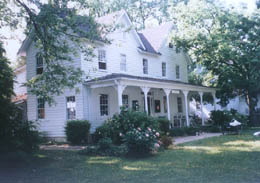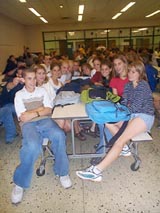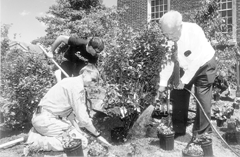

 The New Hartge Nautical Museum: Little Museum; Big History
The New Hartge Nautical Museum: Little Museum; Big History
photos by M.L. Faunce Laurence Hartge readies his family museum for its June
5 opening.
One hundred and sixty years of Hartge family and yachting history will go public in Galesville on Saturday, June 5. Not all of it at one time. For the museum houses the sprawling family's personal history and that of the legendary Chesapeake Bay yacht yard in a modest 14 by 15 feet.
The tiny museum fits into a room of the original house built by Emile Alexander Hartge on property he purchased around 1878. The white frame house facing the West River near Lerch Creek - where Emile and Susan Hartge raised 10 children - stands strong today, still testimony to woodworking skills perfected and passed on through generations.
The new museum is the labor of love of Laurence Hartge, grandson of Emile and keeper of the family history. New Bay Times got a sneak preview of the museum and watched as Laurence, now the eldest Hartge at "82 and one half," used skills that, he says, "come to me naturally."
With a handsaw - "that's the way we learned," he says - Hartge has wrought a small gem. Since the walls of the old house can't talk, he has brought the room to life with memorabilia, photographs, maps, boat models and written accounts of family history and local lore of Chesapeake Bay.
Peter Tasi, a relative, designed the exhibit space and lighting and suggested
how family-owned keepsakes, like the barometer Emile Hartge "would
tap each morning," could best be displayed. The one-room museum is
painted a colonial blue and the original floors show an aged patina. Behind
a window, the West River is hung with leafy oaks. Tasi, of international
reputation, also designed the Barge Museum in Eastport.
Laurence, who calls himself an amateur historian, says that as a teenager he hung around the boatyard and pestered his father, Captain Oscar, and his uncle, Captain Ernest 'Dick' Hartge, for details about the family business. He says his four aunts - Mamie, Laura, Lottie and Ruth - sat him down and named all the log canoes his grandfather had built - in a business that began after the Civil War ended. Their photos and a photo of Emile and Louise Hartge are proudly displayed.
Laurence Hartge, who has enjoyed a variety of careers and interests over his lifetime, will pass on the family history to his own family through the museum. He says he'll "train nieces, nephews and grandchildren to be docents," so they too can be keepers of the family history and the passion for sailing and boating history.
Much of the museum focuses on Captain Emile. The man Laurence calls the "father of Hartge boats" designed and built boats of all types for watermen harvesting the bounty of the Chesapeake: bateaux, log canoes and bugeyes. Models, half models and photos of some of these boats are on display. Included is the 45-foot bugeye, named Florence and Annie, which marine records list as being built by Emile Hartge at Gallows, an earlier name for Galesville and another prominent early family.
Boats built for oystering often carried two different kinds of sails, a rig for working and a rig for racing. Crews would race each other back from the oystering grounds to see who got their product to market first. By the time Ernest 'Dick' Hartge joined his father's business in the 1920s, boats he designed were for both work and pleasure, sail and power. In 1934, he constructed replica ships of the Ark and Dove for the state.
When Captain Dick asked his brother, Captain Oscar, to assume the business of hauling, painting, repairing and docking, Dick dedicated himself to designing and building boats. One of his best known designs was the Chesapeake 20; the Albatross and the Sea Witch are others. Here the West River Sailing Club came to be in the 1940s and '50s.
The history of the Hartge family is not complete without following the life of the first Hartge who came to these shores from Germany in the 1830s. Henry Hartge - craftsman, cabinetmaker and piano manufacturer - began Hartge history just across the river in Shady Side, after moving from Baltimore. At the Hartge Nautical Museum, you can "trace the journey from pianos to boats, to the love of the water, integrity of craftsmanship and especially entrepreneurship" says Laurence.
Today, the modern Hartge Yacht Yard continues that tradition. Near Emile Hartge's original house, namesake Emile Alexander Schlegel operates the yard, a sophisticated business for boat maintenance, repair, remodeling and storage, with 350 slips in Lerch Creek.
The Hartge Nautical Museum opens summer and weekends from 10am to 4pm. When family is not on hand to talk about the exhibits, which will change and evolve, short written histories will guide visitors through the years. Learning the full story of the Hartge family will take time; a lot has happened in 160 years on the West River.
Narrow Church Lane, off Galevsille Road, dead ends at the Hartge Yacht Yard. By opening day, a sign should be posted. The museum is one room on the first floor of Hartge Chesapeake Charters. Parking is at a premium in this active yacht yard, and private property should be in the intimate surrounding neighborhood.
-M.L. Faunce
Around Town
Annapolis Goes French
It's not everyday that one experiences opera within touching distance. Voices accustomed to projecting to the farthest corner of a concert hall can't help but make a mere living room, filled to bursting with trembling tones, reverberate, moving any poor heart lodged there.
About 35 hearts were so moved in the living room of François and Mary Beth Loup as the two offered a May soirée musicale for the Alliance Française of Annapolis.
French, Francophiles and music lovers gathered for this awe-inspiring concert. Many knew that François had performed in Europe's and America's greatest opera houses; fewer perhaps suspected the talent of Mary Beth or François' soprano student Cherelyn Whitney. Guests were alternately amused and sobered, quaked and cradled by François' masterfully nuanced renderings of Lully's "Air de Charon," Ibert's "Don Quichotte," Gounod's "Air de Mephisto" and Delibes' "Stances de Lakmé," among others.
Mary Beth's "Spectre de la Rose" by Berlioz pulled haunting notes seemingly from the depths of each listener, her pure soprano voice lilting and wistful. And Cherelyn's coloratura soprano virtuosity in Gounod's "Air de Juliette" evoked the girlish thrill of first love described by the music. The singers were accompanied by pianist David Chapman, impressive as the stars in his subtle way, deftly supporting, complementing and highlighting them.
In this intimate concert hall, one could follow the score over his shoulder, joining the composer's notes to the performer's interpretation.
Both preceding and following the concert, French and English could be heard mingling over wine, cheese, fruit tarts, and the best, "Frenchest" bread I've tasted in this country.
This kind of comfortable, unpretentious elegance seems to reign over the recent monthly Alliance Française meetings. Mary Beth, the president of the organization, says she is encouraged by the growing membership and positive response to her projects and ideas. She is hoping to hold a future concert like this extraordinary soirée.
Learn more about the Alliance Française from Mary Beth Loup: 410/518-6393 or [email protected].
-Theresa Anne Tornetta
 Southern Teens March for Bucks
Southern Teens March for Bucks
photo by Mary Catherine Ball Katie
Stover, of the March of Dimes, receives an $8,700 check from Southern High
School teacher Joe Marino, student Emily Krug and teachers Lynn Rabik and
Pat Lawlor.
Teens are making news across the country. Southern High School students didn't want to be left out. What's more, they had a better idea: do something right for a change.
These students wanted to make a difference. And they did.
Two hundred-fifty Southern High students walked eight miles each to raise $8,700 in the March of Dimes Walk-A-Thon held earlier this spring.
"We love it. Anne Arundel County is one of the fewer areas that get schools involved. They're doing this for the next generation of kids, to save the babies," said Katie Stover, community director from the March of Dimes.
The money raised will help get hearing screenings for every Maryland infant. Senate Bill 648 called for the infant screening and students helped pay the bill.
"Babies deserve a chance at life regardless of their situation. This seemed like a good opportunity to show America that young children can do as much as companies or industries," said Jessica Sessler, a 14-year-old ninth grader.
"This is a big achievement for Southern High School students. We have never been noticed. This is our time to shine," Sessler added.
That's just what Southern did.
photo by Mary Catherine Ball Students who participated in the March await their pizza
party reward from faculty.
They ranked as March of Dime's top money-raising school in the state, winning over Severna Park High School, which had held the title for several years. What's more, they were the county's top walk team, raising more than several local corporations.
Their $8,700 contribution helped push The March of Dimes above their $52,000 goal for Anne Arundel County.
At a pizza party to honor the students, ninth graders piled into the school cafeteria to celebrate. The room was abuzz with excitement and pride as March of Dimes' Stover presented two trophies honoring their achievement.
"They're all very proud of themselves. We didn't want to just walk and raise money. We wanted to learn what effect the contribution had in the community," said social studies teacher Joseph Marino, one of five teachers involved in the school's community service program, known as Learning Service Projects.
As today's ninth graders follow the paths that lead to high school graduation, they must donate 20 hours of their time to state-mandated community service.
Southern High first adopted March of Dimes last year as the beneficiary of its Service Learning Projects after previous projects - including an anti-smoking campaign - received lukewarm support from students. All that changed when March of Dimes visited the school to advocate the fight against childhood diseases, according to Southern High's service project coordinator and social studies chair Don Richter.
The presentation struck a chord in everyone. "It really tugged at the heart," recalls Richter. Southern High had found its calling. Last year's service project was such a hit with students and faculty that the school decided to team up again with March of Dimes this year.
Students supported the March of Dimes both inside and outside of the classroom. They researched the history of the 50-year-old organization and its mission: in the beginning, to stamp out polio; later, to target other crippling childhood diseases. In government classes, ninth-graders studied legislation that benefits children's health and welfare. They wrote letters to Congress bringing attention to their cause. They created campaign posters. For the Walk-A-Thon, they raised pledges from their community. Then early one Sunday morning in April, they walked.
"The kids had to be there at 7:30. If you know teenagers, you know how hard it is for them to get up that early on a Sunday. For them to do that was an additional sacrifice they were willing to make," observes Richter.
-Mary Catherine Ball with Don Kehne
Seed Money: $200,000 to Green
'2000' Gardens
Comptroller William Donald Schaefer waters
new plantings as part of a volunteer effort to spread Bay-friendly gardens.
Chesapeake Bay has endured more than its share of pollution troubles in the waning years of the first millennium ad. Now the Maryland Commission for Celebration 2000 (aka Maryland 2000) hopes to make amends by sowing gardens brimming with native trees, shrubs, flowers and grasses from the Delmarva flatlands to the Allegany highlands.
And thanks to a plump coffer of grants, one of these gardens may be coming to a patch of dirt near you.
At a ceremony in the lawn of the Louis L. Goldstein Treasury Building in Annapolis, Comptroller William Donald Schaefer dug dirt with an all-volunteer crew of more than 50 treasury office workers to kick off the MaryLandscapes project. Feeding off the joined resources of Maryland 2000 and the Chesapeake Bay Trust, the state-wide project has its sights on planting $200,000 worth of native vegetation.
"I'm proud to join these state employees in planting the first MaryLandscape garden. This will encourage others to see how easy Bay-friendly gardening can be and why it's so important," said Schaefer. Despite his unconventional gardening attire - dark navy slacks, crisp white-collared shirt and dapper red necktie complete with pin - Schaefer looked like he knew his way around a garden.
It's a good thing he did, or he might have gotten lost. Bristling with over 900 plants of 20 different species, the Treasury Building's new garden is a library (reference, not lending) of native plants. Among those planted are 10 that the U.S. Fish and Wildlife Service rates as the best native to Maryland: the serviceberry tree, fringe tree, sweet pepper bush, winterberry holly, mountain laurel, butterfly milkweed, blazing star, bee balm, wild blue indigo and little blue stem grass.
"These native plants serve as excellent additions to a Bay-friendly garden requiring no watering, demanding little maintenance, helping control run-off, providing habitat for animals, functioning as pollinators, and they are available in nurseries around the state," said Britt Slattery, BayScapes coordinator for the U.S. Fish and Wildlife Service.
The virtuous vegetation has aesthetic value, too. The bee balm attracts hummingbirds and bees with its fragrant leaves. The butterfly milkweed's orange flower feeds monarch butterflies from June to September. The mountain laurel, an evergreen bursting in spring with white and pink flowers, thrives in either the warmth of the sun or the chill of the shade.
So why the fuss? Bay-friendly gardening aids the Bay by helping to keep hazardous lawn chemicals, such as pesticides, from entering the state's waterways. Being native, the plants have already adapted to Maryland's resident pests and in turn can do without the harmful chemical treatments. Also, simply put, they already know how to put their roots down in Maryland soil, which makes them more effective at filtering runoff.
The MaryLandscapes project is more than happy to lend you some pocket change so you can plant a few native species of your own, but not quite so directly.
Dave Minges, executive director of the Chesapeake Bay Trust, reports that over 65 community groups, schools, towns and other nonprofits are already vying for 20 grants worth $10,000 apiece to be awarded August 2 - enough to pay for building a garden and maintaining it for at least 10 years.
But first each group must tantalize the MaryLandscapes program with their grand schemes for reforestations or decorative improvements. The only catch is that the projects be exposed for all to see and open for all to tour through. Once the money has been awarded, gardeners have until November of 2000 to plant their projects.
The result, organizers hope, is to create widespread public exhibits - like the Alliance for the Chesapeake Bay's identical BayScapes program that MaryLandscapes is modeled after - where people can come to learn about Maryland's native horticultural wonders and the benefits of planting them.
As the millennium turns, Maryland is coming up native flowers.
-Mary Catherine Ball and Mark Burns
In Virginia, officials are usually a day late and a dollar short in conservation measures. But because of crab shortages in the lower Bay, the state's Marine Resources Commission last week placed a one-year moratorium on crabbing licenses and transfers. And starting next year, watermen must tag their pots so limits can be enforced ...
In Washington, D.C., a coalition of Catholics, Protestants, Evangelicals and Jews has formed the National Religious Partnership for the Environment and vowed to spend $16 million in coming years for green causes. Said Paul Gorman, executive director: "Environmentalism started with Genesis, not Earth Day" ...
Minnesota's governor has turned into Jesse 'The Veto' Ventura. In keeping with his thrifty ways, last week he vetoed $1.5 million for the state's Game and Fish Division and $500,000 for walleye stocking. Layoffs of state employees may result ...
Our Creature Feature is a troubling tale of bear facts from California. Officials have done such a good job bringing back the state's bear population that bears and Californians are having lots more run-ins these days.
As a result, police around Mammoth Lakes are using pepper spray, rubber bullets and fireworks to scare off bears prowling subdivisions in search of food. And last year, the state handed out a record 327 permits to allow homeowners to kill problem bears, the Los Angeles Times reports.